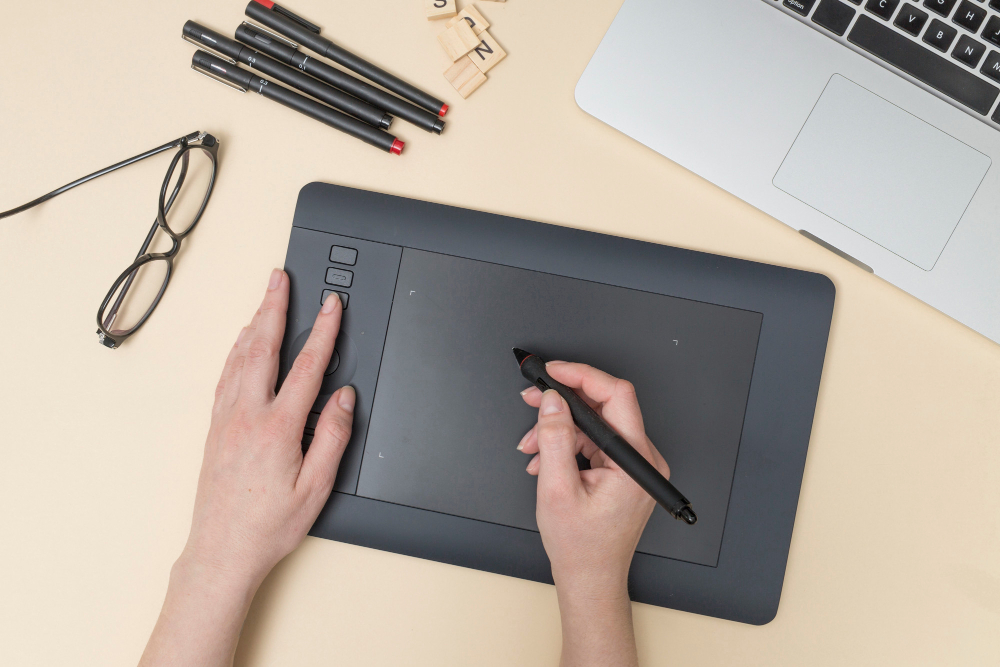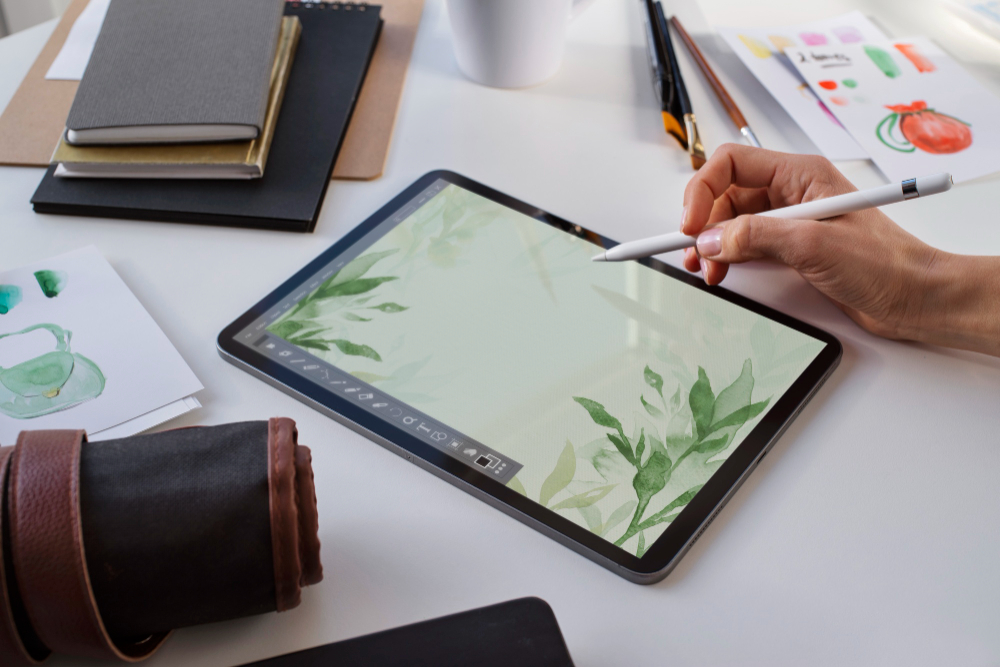Best Online Sketching Tool for Beginners?
Choosing the right digital sketching tool can make a massive difference for beginners in art. While Krita is a popular choice due to its ease of use and no cost, it’s just the start. Looking into other options like BioRender for scientific illustrations, Edrawsoft for varied diagram needs, and GIMP for photo editing and art, can help find the perfect fit. Each tool has unique features that might match different artistic aspirations.
Deciding on the ‘best’ tool for beginners isn’t straightforward. It’s more about matching the software with the user’s needs and learning style.
Key Takeaways
- Online sketching tools cater to various artistic pursuits.
- AutoDraw simplifies drawing with its intuitive AI interface.
- Choose a platform that supports your artistic growth.
Online drawing platforms offer diverse options for beginners. AutoDraw stands out with its easy-to-use AI, ideal for quick sketches. Selecting a tool that aligns with your development as an artist is critical.
Exploring BioRender
Venturing into BioRender reveals a specialized online platform tailored to the scientific community’s unique needs. It boasts over 50,000 icons and 5,000 templates designed to create detailed and accurate scientific illustrations. This tool is a reliable resource for researchers thanks to its commitment to scientific precision. Every icon and template undergoes a meticulous peer-review process, ensuring they meet the highest standards of scientific accuracy.
The interface of BioRender is user-friendly, making it simple for beginners and seasoned scientists to craft high-quality scientific visuals quickly. This extensive selection of templates makes the design process more efficient and serves as an educational guide correctly representing scientific findings. With its emphasis on peer-reviewed accuracy, BioRender provides scientists with a trusted solution for incorporating visuals into their publications, presentations, and grant proposals.
The Versatility of Edrawsoft

Shifting from BioRender’s niche, Edrawsoft shines as a flexible tool. It manages templates and symbols for everything from physics and chemistry to math. Edrawsoft makes crafting precise and clear illustrations easy, perfect for scientific and creative work. It’s especially significant because of its ability to adapt to many different fields. This tool has everything from scientific diagrams to artistic designs, appealing to a broad audience.
Imagine you need to explain a complex system or concept. With Edrawsoft, you can create detailed network diagrams that make complex systems easy to understand. Or, if software engineering is your focus, UML diagrams can bring those abstract concepts to lDiagramsgrams can visually break down theories and experiences for those in physics and chemistry. And for math educators, its mathematical illustrations help demystify abstract concepts.
Edrawsoft isn’t just limited to one device type; its cross-platform compatibility means it works on various operating systems. This accessibility makes it a top choice for anyone looking to create professional-quality diagrams and illustrations across different subjects. Whether for educational purposes or to present ideas more engagingly, Edrawsoft is a valuable tool in your arsenal.
Introduction to GIMP

Moving away from Edrawsoft’s comprehensive features, we now focus on GIMP. This tool offers a unique experience for those starting with digital drawings. GIMP is both free and open-source, making it easily accessible for beginners wanting to dive into the world of image manipulation and graphic creation.
In our upcoming discussion, we’ll get into the basics of GIMP. We’ll talk about what makes it stand out as a top option for creating digital artwork online.
GIMP Basics Explained
GIMP is widely recognized as a powerful yet accessible tool for digital artists, especially those just beginning to navigate the world of digital art. It provides a comprehensive platform for various creative endeavors such as painting, art creation, and digital sketching, positioning itself as the perfect gateway for newcomers to digital artistry.
A Wide Array of Painting Instruments allows users to create digital artwork using brushes and textures that resemble those found in traditional art mediums.
Adaptable Workspace lets users modify their digital environment to suit their preferences, boosting their productivity and creative output.
Layer-based editing enables artists to build complex images layer by layer, ensuring the base image remains unchanged. This feature is crucial for experimenting with different visual elements without the risk of permanently altering the original artwork.
Comprehensive Support is available through detailed guides and a helpful community. This support network is invaluable for beginners, offering guidance and reducing the complexity of learning digital art.
GIMP’s extensive capabilities encourage beginners to develop and polish their digital sketching skills, making it an essential tool in the journey of any aspiring digital artist.
Key Features Highlighted
GIMP has made a name for itself as a versatile platform for budding digital artists. This free tool is perfect for those just starting to dabble in digital art. It’s packed with features that make it easy to use while providing a wide range of capabilities. From multi-layer editing for complex creations to a variety of painting tools that cater to different artistic needs, GIMP has it all. It also supports numerous image formats, simplifying saving and sharing your work.
The interface of GIMP is designed with the user in mind, making it straightforward and accessible. This is a big plus for anyone new to digital sketching, removing the intimidation factor often associated with learning new software. Its ability to handle advanced filters can bring a professional touch to your projects, elevating your art to the next level. For beginners eager to get into digital art without the hassle or expense of more complex software, GIMP stands out as a top choice.
Getting Started With Inkscape

If you’re new to sketching and illustration and considering Inkscape as your go-to tool, you’re on the right path. Inkscape offers a robust environment that supports your creative journey.
Beginners should start by getting comfortable with Inkscape’s essential tools. This is where you learn to create simple shapes, a crucial step for aspiring artists.
As you get better, learning how to use layers effectively is critical. This skill allows you to build more intricate and detailed sketches. It’s all about adding depth and dimension to your work and making your art stand out.
Exploring Inkscape’s Basic Tools
Why not start your journey into vector graphics with Inkscape, a free and open-source vector graphics editor perfect for beginners? Its easy-to-use interface helps newbies grasp the basics of creating precise and impressive artwork.
- Selection Tool: It’s all about moving, scaling, and rotating objects to get them right.
- Drawing Shapes: This is where you create simple geometric shapes to form the basis of your designs.
- Text Tool: Adding and adjusting text becomes a breeze, allowing for more dynamic designs.
- Editing Nodes: This tool is vital for tweaking vector paths and making those fine adjustments that polish a piece.
These core tools lay the groundwork for anyone new to vector graphics, providing a solid base to build from as you get more comfortable and ready to tackle more intricate designs.
Mastering Simple Shapes
Starting your journey with Inkscape, a free vector graphics editor, is a great way to learn how to draw simple shapes. It’s perfect for beginners eager to get into digital sketching. Inkscape makes it easy to work with basic shapes like circles, squares, and triangles, giving you the tools to adjust and resize them. This sets the stage for tackling more complex designs later on.
The program’s user-friendly interface and detailed guides are ideal for anyone new to sketching. They make it straightforward to get better at creating detailed illustrations from simple components. As a beginner, focusing on these basic shapes in Inkscape is an intelligent way to improve your skills in digital art.
Utilizing Layers Effectively
Inkscape’s layering system is a game-changer for beginners diving into digital art. It simplifies the process of organizing and refining sketches, making it easier to tackle complex designs.
Here’s a breakdown of how layers can elevate your Inkscape projects:
- Dividing Sketch Components: You gain more control by placing different parts of your artwork on separate layers. This separation allows you to edit one part of your drawing without affecting the rest.
- Isolated Edits: Focusing on a single layer means you can tweak your art piece by piece. This keeps your overall design safe from unintended changes.
- Control Over Visibility: The ability to hide or show layers as needed helps you concentrate on specific areas. This feature is handy when working on detailed parts of your artwork.
- Layer Reordering: Moving layers around changes how elements appear about each other. This is key for achieving the perfect composition in your artwork.
These aspects of Inkscape’s layer system support beginners in managing their digital sketches effectively.
Discovering BioIcons

Venturing into the world of scientific visualization, BioIcons stands out as a critical resource for those in the scientific community. It offers over 2,300 free scientific icons, making it easier for researchers and scientists to craft precise and engaging diagrams.
This collection spans a broad spectrum of scientific fields, proving crucial for improving scientific presentations. What makes BioIcons exceptionally valuable is its dedication to scientific accuracy. Each icon undergoes a peer-review process to ensure it conforms to the high standards expected in scientific work.
Creative Freedom With Draw.Io
Discovering the world of Draw.io offers a gateway to creative expression for those new to the art of drawing. Its wide array of tools, user-friendly setup, and the fact that it’s free makes it a go-to choice for anyone looking to start their design journey.
Ease of use and the variety of shapes, icons, and templates available online encourage users to experiment and share their creations with others. This fosters a community where ideas flow freely, making Draw.io a valuable tool for beginners in sketching.
Versatile Tool Palette
Draw.io makes diagramming and sketching easy and fun, offering various shapes, icons, and connectors. It’s perfect for beginners and provides a user-friendly drag-and-drop interface. This platform allows for deep customization, making your diagrams look precisely how you want.
- Rich Library: Find everything you need with thousands of shapes and icons.
- Simple to Use: Drag and drop to add and organize your diagram elements.
- Make it Yours: Change colors, sizes, and styles to reflect your unique ideas.
- Team Up: Collaborate with others in real-time, sharing feedback and ideas as you go.
Choosing Draw.io means getting an accessible yet powerful tool for all your diagram needs. It’s designed to make the process smooth and enjoyable, whether you’re working alone or with a team.
User-Friendly Interface
Building on its wide range of tools, Draw.io makes designing sketches simple with its straightforward interface. The platform is known for its ease of use, featuring drag-and-drop capabilities, allowing beginners to handle various shapes, icons, and connectors efficiently.
These functions make it easier for users to improve their drawing skills and encourage them to express their creativity freely. Draw.io also allows real-time collaboration, enabling people to collaborate on projects from anywhere.
This collaborative aspect and the tool’s compatibility with multiple file formats make sharing and exporting work across different devices straightforward. Draw.io is a top recommendation for anyone new to online sketching.
Free Access Online
Draw.io opens up the world of drawing for everyone by offering its services for free online. This makes it perfect for beginners who want to start their drawing journey without worrying about costs. As an open-source platform, Draw.io is incredibly user-friendly, making drawing more straightforward. It’s accessible directly online, so there is no need to download anything, which is excellent for newcomers eager to dive into the drawing.
The platform is known for its easy-to-use drag-and-drop interface. It also allows users to customize their drawings with various shapes to meet different needs. One of the standout features of Draw.io is the ability to work with others in real time, which can be incredibly helpful for beginners looking for feedback. Plus, it works well with other platforms like Google Drive and Dropbox, ensuring users can save and share their work effortlessly.
These features are designed to give beginners the tools they need to express their creativity freely and effectively, positioning Draw.io as an excellent starting point for anyone new to drawing.
Sketchpad for Beginners
Sketchpad is an online tool perfect for those new to digital sketching. It’s designed to be simple, removing the intimidation factor often associated with starting digital art. The interface is clean and user-friendly, featuring essential tools like pencils for drawing freely, shapes for adding structure, and a colorful palette to bring your ideas to life. This setup encourages new users to get comfortable with digital sketching by focusing on the basics.
This tool is great for learning because it lets you create layers and use undo/redo options. This means you can quickly try different styles or correct mistakes, which is crucial for improving your skills. Sketchpad also makes saving and sharing your artwork in various formats easy. Since it works right in your web browser, you don’t have to deal with any downloads or installations, making it a hassle-free option for beginners looking to start their sketching journey online.
AutoDraw’s AI Assistance
AutoDraw’s AI assistance taps into the power of machine learning to upgrade your simple sketches into impressive illustrations. It’s perfect for those just starting with digital sketching. The tool uses artificial intelligence to understand your drawings and offers a selection of polished illustrations. This improves the look of your sketches and helps you get better at drawing by learning through doing.
Here’s how AutoDraw’s AI makes sketching better:
- Drawing Suggestions: The tool’s algorithms analyze your sketches on the spot and suggest a variety of accurate illustrations.
- Customization: You can tweak these suggestions to match your unique creative vision.
- Accessibility: Since AutoDraw is an online tool, you can use it immediately without installing anything, making it super accessible for beginners.
- Skill Improvement: The AI helps by making sense of your sketches and proposing enhancements, guiding novices toward mastering the art of creating more organized and eye-catching artwork.
AutoDraw is an invaluable resource for anyone aiming to refine their drawing and sketching abilities. It smooths the transition from simple doodles to professional illustrations, making learning to draw fun and engaging.
The Basics of TikZ
TikZ is a powerful tool within the LaTeX setup, perfect for creating precise and detailed graphics for various documents. This tool is essential for anyone looking to add complex diagrams, illustrations, or visualizations to their work, offering unmatched precision and flexibility. With TikZ, users can place nodes, draw curves, and position text with exactness, making sure every graphic detail is just right.
One of the best features of TikZ is its ability to be completely customized. This means users can adjust colors, styles, shapes, and sizes to get their graphics looking exactly how they want. This customization ensures that the visuals deliver the intended message and match the user’s style. Integrating these graphics into LaTeX documents, TikZ ensures that the final presentations look polished and professional.
For those working within LaTeX, TikZ is an invaluable resource for adding sophisticated graphics to their documents. It’s a vital tool for making documents more precise and impactful, showcasing the power of well-designed visuals.
Chemdraw for Scientific Art
While TikZ is excellent for creating detailed graphics in LaTeX documents, ChemDraw is the preferred tool for scientists who need to develop accurate chemical and scientific illustrations. It’s known for its precision and ease of use, making it a must-have for anyone in scientific art. Both academic and industrial sectors rely on ChemDraw for its ability to produce publication-quality scientific illustrations.
ChemDraw shines because of it:
- Provides various drawing tools for crafting complex chemical structures, reactions, and diagrams accurately.
- It has an easy-to-use interface makes creating scientific illustrations straightforward, even for those new to the software.
- Delivers precise illustrations that meet the standards of leading scientific journals.
- It is a trusted source for scientists needing accurate illustrations to represent their research.
This software is essential for creating detailed and accurate representations of chemical structures and reactions, making complex concepts easier to understand and communicate. Its user-friendly nature ensures that even newcomers can produce high-quality scientific art. At the same time, its precision makes it a reliable tool for professionals aiming to share their discoveries with the world.
Frequently Asked Questions
Which Sketch Is Best for Beginners?
- Beginners benefit from easy sketches.
- Practice with different pencils is critical.
- Simplify learning with the right tools.
What Is the Best Free Drawing Software for Beginners?
- Easy to learn, perfect for new artists.
- Cross-platform use increases accessibility.
- Strong community support boosts learning.
What Is the Best Tool for Sketching?
- Practice drawing gestures to capture movement quickly.
- Understand artistic anatomy for realistic sketches.
- Choose the proper sketchbook for your work.
What Website to Use to Draw?
Choosing a drawing platform? Consider these points:
- Look for user-friendly interfaces; they speed up learning.
- Interactive tutorials help you master skills quickly.
- Community feedback and device support enhance the experience.
Conclusion
The online sketching tools market is brimming with options for those new to digital art. From Chemdraw’s precise scientific diagrams to AutoDraw’s user-friendly interface powered by artificial intelligence, there’s something out there for every kind of artist. Whether your interest lies in creating detailed illustrations or just looking for a simple platform to start practicing your skills, the key is finding a tool that matches your needs and comfort level. This step is crucial for anyone looking to grow their abilities in digital sketching and expand their creative expression.
Choosing the right platform is about understanding what you want to achieve and how much effort you will put into learning. Some tools are designed, making them ideal for beginners who might feel overwhelmed by more complex software. On the other hand, if you aim to develop a more technical skill set, you might lean towards applications offering a range of advanced features. AutoDraw, for instance, is a great starting point for those who want to get their ideas down quickly without worrying about perfection, thanks to its intuitive design.
In short, the best tool for you is one that not only fits your current skill level but also has the potential to support your growth as an artist. Diving into digital art can initially seem intimidating, but with the right resources, it can become a rewarding journey.